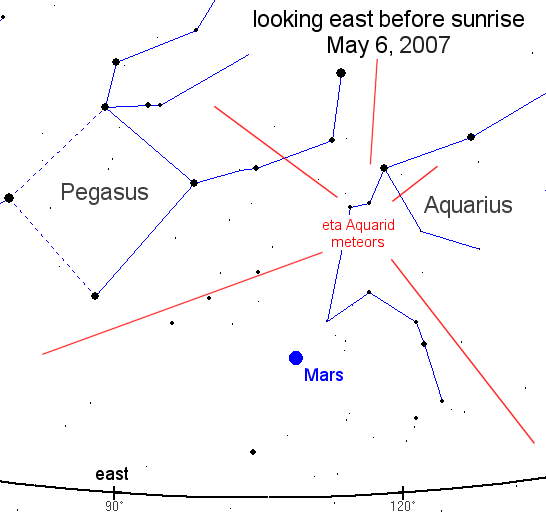The eta Aquarid Meteor Shower
 The eta Aquarid meteor shower peaks this year on Sunday, May 6th. The best time to look, no matter where you live, is during the hours immediately before sunrise on Sunday morning. As usual, you will see more meteors from the dark countryside. Get away from city lights! Unfortunately, there is one source of light you cannot escape: the gibbous Moon. Glaring moonlight will wipe out all but the brightest eta Aquarids in 2007.
The eta Aquarid meteor shower peaks this year on Sunday, May 6th. The best time to look, no matter where you live, is during the hours immediately before sunrise on Sunday morning. As usual, you will see more meteors from the dark countryside. Get away from city lights! Unfortunately, there is one source of light you cannot escape: the gibbous Moon. Glaring moonlight will wipe out all but the brightest eta Aquarids in 2007.
This is mainly a southern hemisphere shower, but northern observers can see it, too. Expected meteor rates: 5 to 10 per hour in the northern hemisphere, 20 to 60 per hour in the southern hemisphere. (Lunar interference could reduce these figures by factors of two or three.) Latitudes between the equator and 30 degrees south are favored: this includes most of Australia, South America and southern Africa.
The Eta Aquarids are flakes of dust from Halley's Comet, which last visited Earth in 1986. Although the comet is now far away, beyond the orbit of Uranus, it left behind a stream of dust. Earth passes through the stream twice a year in May and October. In May we have the eta Aquarid meteor shower, in October the Orionids. Both are caused by Halley's Comet.
The eta Aquarids are named after a 4th-magnitude star in the constellation Aquarius. The star has nothing to do with the meteor shower except that, coincidentally, meteors appear to emerge from a point nearby. Eta Aquarii is 156 light years from Earth and 44 times more luminous than the Sun.
The constellation Aquarius does not rise very far above the horizon in the northern hemisphere, and that's why northerners see relatively few meteors. But the ones they do see could be spectacular Earthgrazers.
Earthgrazers are meteors that skim horizontally through the upper atmosphere. They are slow and dramatic, streaking far across the sky. The best time to look for Earthgrazers is between 2:00 to 2:30 a.m. local time when Aquarius is just peeking above the horizon.
Experienced meteor watchers suggest the following viewing strategy: Dress warmly. Bring a reclining chair, or spread a thick blanket over a flat spot of ground. Lie down and look up somewhat toward the east. Meteors can appear in any part of the sky, although their trails will point back toward Aquarius.
Source






